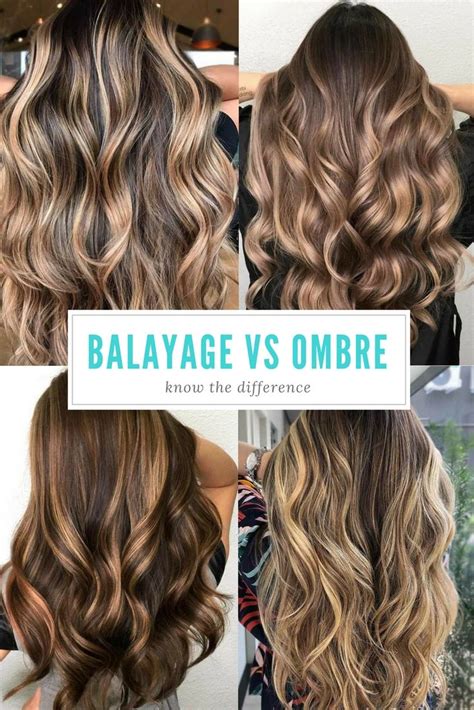Introduction

When it comes to hair coloring, balayage and ombre have emerged as two of the most popular techniques, captivating the hearts of fashionistas and hair enthusiasts alike. Both techniques create stunning and dimensional color effects, but they also have distinct characteristics that cater to different preferences and hair goals. This comprehensive guide will explore the intricate world of balayage vs ombre, delving into their similarities, differences, and the benefits and drawbacks of each.
Understanding Balayage
Balayage is a French term that translates to “sweeping,” accurately describing the freehand painting technique used to create soft, natural-looking highlights. Unlike traditional foiling, balayage involves the application of color directly to the hair, without the use of foils or caps. The stylist uses a brush to sweep the color from the roots to the ends, creating a seamless blend and a sun-kissed effect.
Benefits of Balayage:
- Natural and Gradual: Creates soft, blended highlights that mimic natural hair growth.
- Low Maintenance: Requires less frequent touch-ups compared to other highlighting techniques.
- Versatile: Can be customized to suit individual hair types, face shapes, and skin tones.
- Dimensional: Adds depth and dimension to hair, giving it a fuller and more vibrant appearance.
Understanding Ombre
Ombre is a hair coloring technique that creates a gradual transition from one color to another. Unlike balayage, ombre involves dividing the hair into sections and applying color in a more precise manner. The result is a noticeable color gradient, with darker roots blending seamlessly into lighter ends.
Benefits of Ombre:
- Dramatic and Edgy: Creates a striking and bold color statement.
- Long-Lasting: The color gradient can last for several months, requiring minimal touch-ups.
- Suitable for All Hair Colors: Can be done on any hair color, from dark brunette to platinum blonde.
- Revitalizing: Gives dull and lifeless hair a fresh and vibrant boost.
Balayage vs Ombre: A Detailed Comparison
To help you make an informed decision between balayage and ombre, here is a detailed table comparing their key characteristics:
| Feature | Balayage | Ombre |
|---|---|---|
| Technique | Freehand painting | Sectioned and precise |
| Color Placement | From roots to ends, blended | Gradual transition from roots to ends |
| Effect | Soft, natural highlights | Dramatic color gradient |
| Maintenance | Low maintenance | Medium maintenance |
| Versatility | Highly customizable | Limited customization |
| Best Suited For | Natural-looking color | Bold and edgy statement |
Choosing the Right Technique for You
The choice between balayage and ombre ultimately depends on your individual preferences and hair goals. Consider the following factors when making your decision:
- Hair Type: Balayage is more suitable for finer hair types, as it creates soft and delicate highlights. Ombre, on the other hand, can work well on both fine and thick hair.
- Color Goal: If you desire a subtle and natural enhancement, balayage is an excellent choice. If you want a more dramatic and edgy look, opt for ombre.
- Maintenance: Balayage requires less frequent touch-ups, while ombre may require more frequent visits to the salon.
- Price: The cost of balayage and ombre can vary depending on the length and thickness of your hair, as well as the expertise of the stylist.
Pros and Cons of Balayage and Ombre
Pros of Balayage:
- Natural and blended highlights
- Low maintenance
- Versatile
- Adds dimension and depth
Cons of Balayage:
- May not create a dramatic enough effect for some
- Can be more time-consuming than ombre
Pros of Ombre:
- Dramatic and bold statement
- Long-lasting
- Suitable for all hair colors
- Revitalizes dull hair
Cons of Ombre:
- Limited customization
- Medium maintenance
- Can be harsh on damaged hair
Emerging Trends in Balayage and Ombre
The world of hair coloring is constantly evolving, with new techniques and trends emerging all the time. Here are some of the latest innovations in balayage and ombre:
- Root Shadowing: Adding subtle depth to the roots to create a more natural look.
- Reverse Ombre: Creating a gradient from dark ends to lighter roots.
- Sombré: A softer and more subtle version of ombre.
- Babylights: Extremely fine highlights that create a natural and youthful appearance.
Conclusion
Balayage and ombre are both versatile and captivating hair coloring techniques that can transform your look. Whether you crave natural-looking highlights or a bold and dramatic statement, there is a technique that will meet your needs. By understanding the similarities, differences, and benefits of each technique, you can make an informed decision and achieve the perfect hair color for your unique style.
